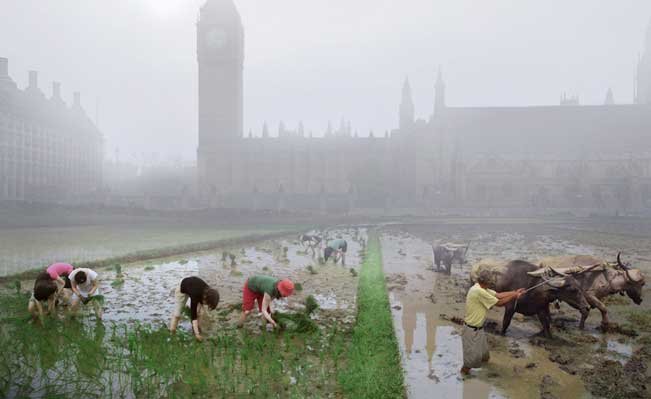 Robert Graves and Didier Madoc-Jones
Robert Graves and Didier Madoc-Jones
This Saturday the People’s Assembly will be taking over Parliament Square. Merlin Fulcher writes of the need to democratise this symbolic public space
This Saturday (21 June) thousands of anti-Coalition demonstrators will transform London’s Parliament Square into the vibrant venue for a free festival against austerity. Starting midday outside the BBC on Portland Place, the spirited march will be a symbol of defiance against our government’s economically and socially destructive policies.
This latest in a long line of peaceful protests to occupy the small green square opposite Westminster Hall will rightly seek to expose the worrying inequality perpetuated by the greediest at the top of society. But – perhaps unintentionally – it will also expose the deeply flawed physical space damaging the heart of our democracy. A public space which many believe needs fixing now more than ever.
Surrounded by a gyratory road system which threatens to scythe down any brave visitor, Parliament Square is a bleak island cut off from our buzzing metropolis. While London has rapidly grown to become one of the world’s greatest social and digital melting pots, this patchy village green with its aging statuary and toxic air has remained stuck in time.
Such barrenness and seclusion right in the physical centre of government is embarrassing, not least because the square is next to the Palace of Westminster which attracts millions of curious visitors a year. But it is also potentially catastrophic because Britain’s voters have now made their distrust of the established political order abundantly clear. Could a more welcoming space boost trust in democracy and lighten the disillusioned base supporting far right parties?
Sadly, many noble attempts to rehabilitate Parliament Square and to create participatory forums for political discourse in recent history have failed. Brian Haw railed against foreign policy in Afghanistan and Iraq with banners graphically exposing the horrors of war. His solitary protest articulated the unease of millions but the political establishment remained silent behind its edifice and after ten years on the traffic island wilderness he died of lung cancer.
This tragic episode – coupled with the hasty dissolution of Democracy Village and the violent kettling of peaceful student demonstrators in 2010 – has earned it a reputation as a place where political discussion cannot thrive. The sad fact however is that earnest attempts to improve this nationally-significant environment have been consciously undermined.
Immediately following his election as London mayor in 2008 Boris Johnson abandoned an £18 million redevelopment vision which would have seen one side of the square pedestrianised. Had the project proceeded the world would have had a fitting setting for next year’s 800th anniversary celebration of the Magna Carta being signed.
At the time Johnson argued the urgent upgrading of London’s transport infrastructure was more pressing. Considering his political ambition and penchant for vanity projects however, Johnson’s reluctance to take on London’s biggest public realm problem could be scarcely be more contrived. While the Orbit, Boris Bike and New London Routemaster make him individually look good, upgrading Parliament Square would uplift an entire vicinity.
Sit quietly in the centre of Parliament Square and you will feel the occasional rumble of the London Underground line which slices diagonally beneath the surface along with a network of secretive government tunnels designed to withstand a nuclear attack. Look around and on each side of the square stand the most venerable institutions of the state. To the east is Parliament and to the south Britain’s most sacred religious building – Westminster Abbey. To the west sits the Supreme Court and to the north is HM Treasury.
Look within the square and you will find statues depicting wartime prime minister Winston Churchill and US president Abraham Lincoln. These historical heavyweights are joined by an array of statesmen and the anti-Apartheid revolutionary Nelson Mandela. Bearing in mind Johnson’s attempts to introduce a statue of Margaret Thatcher, it is clear Parliament Square is a landscape full of complex symbols too potent for the mayor to handle with any artistry. Where, for example, is the strategy to create an open accessible platform embracing the digitally-empowered participants of modern politics?
City Hall’s continued ownership of the green is evidently ludicrous when those who stand most to gain from its improvement are parliament, the nation, the internet and the world. The mayor – whose physical power base is miles away in London Bridge – has had six years to use it, has done nothing with it and should now lose it. This neglected area is too important to fall foul of the mayoral cult of personality. It should be taken out of regional ownership and instead nationalised – or better still, internationalised.
Then we can bring a positive future for Parliament Square as far forward into the present as possible. Let us start with the basics and the latest in civilisation. Introduce drinking water, 24-hour washrooms, seating, shelter, lighting, free Wifi internet and wireless charging facilities. This would be London’s new commercial and institutional-free forum for creativity. It would create an intellectual arrival hub welcoming visitors from around the world, a modern day speakers’ corner – a new tweeters’ corner. The change must happen now because those with the power to create a better future are demanding greater participation and their demands should be welcomed in Parliament Square.

